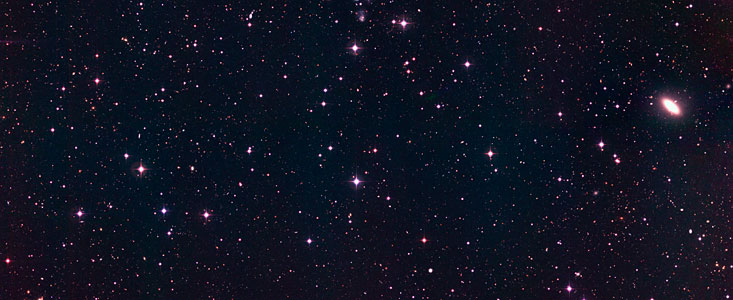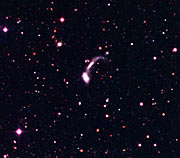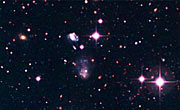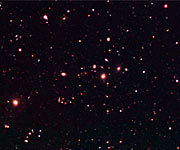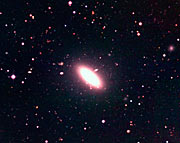Tisková zpráva
The Capodimonte Deep Field
A Window towards the Distant Universe
10. dubna 2001
The Osservatorio Astronomico Capodimonte Deep Field (OACDF) is a multi-colour imaging survey project that is opening a new window towards the distant universe. It is conducted with the ESO Wide Field Imager (WFI) , a 67-million pixel advanced camera attached to the MPG/ESO 2.2-metre telescope at the La Silla Observatory (Chile). As a pilot project at the Osservatorio Astronomico di Capodimonte (OAC) [1], the OACDF aims at providing a large photometric database for deep extragalactic studies, with important by-products for galactic and planetary research. Moreover, it also serves to gather experience in the proper and efficient handling of very large data sets, preparing for the arrival of the VLT Survey Telescope (VST) with the 1 x 1 degree 2 OmegaCam facility.
The Capodimonte Deep Field
With the comparatively few large telescopes available in the world, it is not possible to study the Universe to its outmost limits in all directions. Instead, astronomers try to obtain the most detailed information possible in selected viewing directions, assuming that what they find there is representative for the Universe as a whole.
This is the philosophy behind the so-called "deep-field" projects that subject small areas of the sky to intensive observations with different telescopes and methods. The astronomers determine the properties of the objects seen, as well as their distances and are then able to obtain a map of the space within the corresponding cone-of-view (the "pencil beam"). Recent, successful examples of this technique are the "Hubble Deep Field" and the "Chandra Deep Field" (eso0106).
In this context, the Capodimonte Deep Field (OACDF) is a pilot research project, now underway at the Osservatorio Astronomico di Capodimonte (OAC) in Napoli (Italy). It is a multi-colour imaging survey performed with the Wide Field Imager (WFI), a 67-million pixel (8k x 8k) digital camera that is installed at the 2.2-m MPG/ESO Telescope at ESO's La Silla Observatory in Chile.
The scientific goal of the OACDF is to provide an important database for subsequent extragalactic, galactic and planetary studies. It will allow the astronomers at OAC - who are involved in the VLT Survey Telescope (VST) project - to gain insight into the processing (and use) of the large data flow from a camera similar to, but four times smaller than the OmegaCam wide-field camera that will be installed at the VST.
The field selection for the OACDF was based on the following criteria:
- There must be no stars brighter than about 9th magnitude in the field, in order to avoid saturation of the CCD detector and effects from straylight in the telescope and camera. No Solar System planets should be near the field during the observations;
- It must be located far from the Milky Way plane (at high galactic latitude) in order to reduce the number of galactic stars seen in this direction;
- It must be located in the southern sky in order to optimize observing conditions (in particular, the altitude of the field above the horizon), as seen from the La Silla and Paranal sites;
- There should be little interstellar material in this direction that may obscure the view towards the distant Universe;
- Observations in this field should have been made with the Hubble Space Telescope (HST) that may serve for comparison and calibration purposes.
Based on these criteria, the astronomers selected a field measuring about 1 x 1 deg 2 in the southern constellation of Corvus (The Raven). This is now known as the Capodimonte Deep Field (OACDF). The above photo (ESO Press Photo eso0116a) covers one-quarter of the full field (Subfield No. 2 - OACDF2) - some of the objects seen in this area are shown below in more detail. More than 35,000 objects have been found in this area; the faintest are nearly 100 million fainter than what can be perceived with the unaided eye in the dark sky.
Poznámky
[1] The team members are: Massimo Capaccioli, Juan M. Alcala', Roberto Silvotti, Magda Arnaboldi, Vincenzo Ripepi, Emanuella Puddu, Massimo Dall'Ora, Giuseppe Longo and Roberto Scaramella .
[2] This is a preliminary result by Juan Alcala', Massimo Capaccioli, Giuseppe Longo, Mikhail Sazhin, Roberto Silvotti and Vincenzo Testa , based on recent observations with the Telescopio Nazionale Galileo (TNG) which show that the spectra of the two objects are identical.
Další informace
Technical Information about the OACDF Survey
The observations for the OACDF project were performed in three different ESO periods (18-22 April 1999, 7-12 March 2000 and 26-30 April 2000). Some 100 Gbyte of raw data were collected during each of the three observing runs. The first OACDF run was done just after the commissioning of the ESO-WFI.
The observational strategy was to perform a 1 x 1 deg 2 short-exposure ("shallow") survey and then a 0.5 x 1 deg 2 "deep" survey.
The shallow survey was performed in the B, V, R and I broad-band filters. Four adjacent 30 x 30 arcmin 2 fields, together covering a 1 x 1 deg 2 field in the sky, were observed for the shallow survey. Two of these fields were chosen for the 0.5 x 1 deg 2 deep survey; OACDF2 shown above is one of these.
The deep survey was performed in the B, V, R broad-bands and in other intermediate-band filters.
The OACDF data are fully reduced and the catalogue extraction has started. A two-processor (500 Mhz each) DS20 machine with 100 Gbyte of hard disk, specifically acquired at the OAC for WFI data reduction, was used. The detailed guidelines of the data reduction, as well as the catalogue extraction, are reported in a research paper that will appear in the European research journal Astronomy & Astrophysics.
Kontakty
Juan M. Alcala' Estrada
Osservatorio Astronomico di Capodimonte
Napoli, Italy
Tel.: +39-081-5575479
Email: jmae@na.astro.it
Roberto Silvotti
Osservatorio Astronomico di Capodimonte
Napoli, Italy
O zprávě
| Tiskové zpráva č.: | eso0116 |
| Legacy ID: | Photo 15a-f/01 |
| Jméno: | Capodimonte Deep Field |
| Typ: | Early Universe : Galaxy : Activity : AGN : Quasar Early Universe : Cosmology : Morphology : Deep Field |
| Facility: | MPG/ESO 2.2-metre telescope |
| Instruments: | WFI |
Our use of Cookies
We use cookies that are essential for accessing our websites and using our services. We also use cookies to analyse, measure and improve our websites’ performance, to enable content sharing via social media and to display media content hosted on third-party platforms.
ESO Cookies Policy
The European Organisation for Astronomical Research in the Southern Hemisphere (ESO) is the pre-eminent intergovernmental science and technology organisation in astronomy. It carries out an ambitious programme focused on the design, construction and operation of powerful ground-based observing facilities for astronomy.
This Cookies Policy is intended to provide clarity by outlining the cookies used on the ESO public websites, their functions, the options you have for controlling them, and the ways you can contact us for additional details.
What are cookies?
Cookies are small pieces of data stored on your device by websites you visit. They serve various purposes, such as remembering login credentials and preferences and enhance your browsing experience.
Categories of cookies we use
Essential cookies (always active): These cookies are strictly necessary for the proper functioning of our website. Without these cookies, the website cannot operate correctly, and certain services, such as logging in or accessing secure areas, may not be available; because they are essential for the website’s operation, they cannot be disabled.
Functional Cookies: These cookies enhance your browsing experience by enabling additional features and personalization, such as remembering your preferences and settings. While not strictly necessary for the website to function, they improve usability and convenience; these cookies are only placed if you provide your consent.
Analytics cookies: These cookies collect information about how visitors interact with our website, such as which pages are visited most often and how users navigate the site. This data helps us improve website performance, optimize content, and enhance the user experience; these cookies are only placed if you provide your consent. We use the following analytics cookies.
Matomo Cookies:
This website uses Matomo (formerly Piwik), an open source software which enables the statistical analysis of website visits. Matomo uses cookies (text files) which are saved on your computer and which allow us to analyze how you use our website. The website user information generated by the cookies will only be saved on the servers of our IT Department. We use this information to analyze www.eso.org visits and to prepare reports on website activities. These data will not be disclosed to third parties.
On behalf of ESO, Matomo will use this information for the purpose of evaluating your use of the website, compiling reports on website activity and providing other services relating to website activity and internet usage.
Matomo cookies settings:
Additional Third-party cookies on ESO websites: some of our pages display content from external providers, e.g. YouTube.
Such third-party services are outside of ESO control and may, at any time, change their terms of service, use of cookies, etc.
YouTube: Some videos on the ESO website are embedded from ESO’s official YouTube channel. We have enabled YouTube’s privacy-enhanced mode, meaning that no cookies are set unless the user actively clicks on the video to play it. Additionally, in this mode, YouTube does not store any personally identifiable cookie data for embedded video playbacks. For more details, please refer to YouTube’s embedding videos information page.
Cookies can also be classified based on the following elements.
Regarding the domain, there are:
- First-party cookies, set by the website you are currently visiting. They are stored by the same domain that you are browsing and are used to enhance your experience on that site;
- Third-party cookies, set by a domain other than the one you are currently visiting.
As for their duration, cookies can be:
- Browser-session cookies, which are deleted when the user closes the browser;
- Stored cookies, which stay on the user's device for a predetermined period of time.
How to manage cookies
Cookie settings: You can modify your cookie choices for the ESO webpages at any time by clicking on the link Cookie settings at the bottom of any page.
In your browser: If you wish to delete cookies or instruct your browser to delete or block cookies by default, please visit the help pages of your browser:
Please be aware that if you delete or decline cookies, certain functionalities of our website may be not be available and your browsing experience may be affected.
You can set most browsers to prevent any cookies being placed on your device, but you may then have to manually adjust some preferences every time you visit a site/page. And some services and functionalities may not work properly at all (e.g. profile logging-in, shop check out).
Updates to the ESO Cookies Policy
The ESO Cookies Policy may be subject to future updates, which will be made available on this page.
Additional information
For any queries related to cookies, please contact: pdprATesoDOTorg.
As ESO public webpages are managed by our Department of Communication, your questions will be dealt with the support of the said Department.
